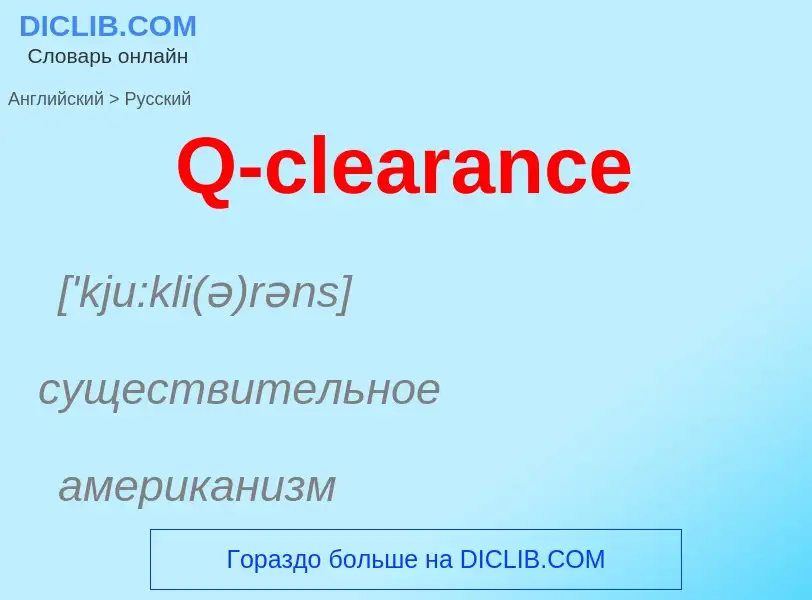Перевод и анализ слов искусственным интеллектом ChatGPT
На этой странице Вы можете получить подробный анализ слова или словосочетания, произведенный с помощью лучшей на сегодняшний день технологии искусственного интеллекта:
- как употребляется слово
- частота употребления
- используется оно чаще в устной или письменной речи
- варианты перевода слова
- примеры употребления (несколько фраз с переводом)
- этимология
Q-clearance - перевод на русский
['kju:kli(ə)rəns]
существительное
американизм
допуск к совершенно секретной информации
[kju:]
общая лексика
Quarter
квартал [года]
существительное
общая лексика
17-я буква английского алфавита
[kju:]
существительное
общая лексика
17-я буква английского алфавита
кварта (мера объема для жидких и сыпучих тел: в Англии - 1,136 л в США - 0,946 л для жидких и 1,101 л для сыпучих тел)
кварто (полиграфическая мера)
вопрос
квинтал (в метрической системе мер - 100 кг в Англии - 50,8 кг в США - 45,36 кг)
синоним
Определение
Википедия
Q clearance or Q access authorization is the U.S. Department of Energy (DOE) security clearance required to access Top Secret Restricted Data, Formerly Restricted Data, and National Security Information, as well as Secret Restricted Data. Restricted Data (RD) is defined in the Atomic Energy Act of 1954 and covers nuclear weapons and related materials. The lower-level L clearance is sufficient for access to Secret Formerly Restricted Data (FRD) and National Security Information, as well as Confidential Restricted Data, Formerly Restricted Data, and National Security Information. Access to Restricted Data is only granted on a need-to-know basis to personnel with appropriate clearances.
A Q Clearance is equivalent to a U.S. Department of Defense Top Secret clearance. "...the Q access authorization corresponds to the background investigation and administrative determination similar to what is completed by other agencies for a Top Secret National Security Information access clearance."
Anyone possessing an active Q clearance is always categorized as holding a National Security Critical-Sensitive position (sensitivity Level 3). Additionally, most Q-cleared incumbents will have collateral responsibilities designating them as Level 4: National Security Special-Sensitive personnel. With these two designations standing as the highest-risk sensitivity levels, occupants of these positions hold extraordinary accountability, having the potential to cause "exceptionally grave" or "inestimable" damage to the national security of the United States.
In addition to classification levels, three categories of classified matter are identified: Restricted Data (RD), Formerly Restricted Data (FRD), and National Security Information (NSI), as well as a class of access-restricted materials: special nuclear material (SNM). The employee must have a security level clearance consistent with their assignment. Common combinations are reflected in the table on the right.
Much of the DOE information at this level requires access to Critical Nuclear Weapon Design Information (CNWDI, pronounced "SIN-widee"). Such information bears the page marking Top Secret//RD-CNWDI and the paragraph marking (TS-N) or (TS//RD-CNWDI). The DOE security clearance process is overseen by the Department of Energy Office of Hearings and Appeals.
DOE clearances apply for access specifically relating to atomic or nuclear related materials ("Restricted Data" under the Atomic Energy Act of 1954). The clearance is issued predominantly to non-military personnel. In 1946, U.S. Army Counter Intelligence Corps Major William L. Uanna, in his capacity as the first Chief of the Central Personnel Clearance Office at the newly formed Atomic Energy Commission, named and established the criteria for the Q Clearance. The security clearance process at the DOE is adjudicated by the DOE Office of Hearings and Appeals (OHA), where an individual whose security clearance is at issue may seek to appeal a security clearance decision to an administrative judge, and subsequently, to an appeal panel.
As of 1993, Q Clearances required a single-scope background investigation of the previous ten years of the applicant's life by both the Office of Personnel Management and the Federal Bureau of Investigation, and as of 2019, cost $5,596.
As of April 2021, there were 92,177 people who held a Q clearance.

![POPVLVSQVE]]", was carved into [[Trajan's column]] c. [[AD]] 113. POPVLVSQVE]]", was carved into [[Trajan's column]] c. [[AD]] 113.](https://commons.wikimedia.org/wiki/Special:FilePath/Base columna trajana.jpg?width=200)
![A long-tailed Q as drawn by French typographer [[Geoffroy Tory]] in his 1529 book ''Champfleury'' A long-tailed Q as drawn by French typographer [[Geoffroy Tory]] in his 1529 book ''Champfleury''](https://commons.wikimedia.org/wiki/Special:FilePath/Champfleury letter Q illustration Geoffroy Tory (1529).png?width=200)
